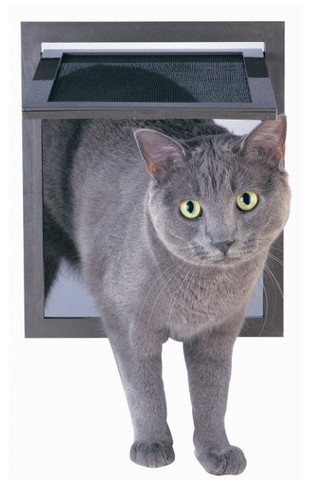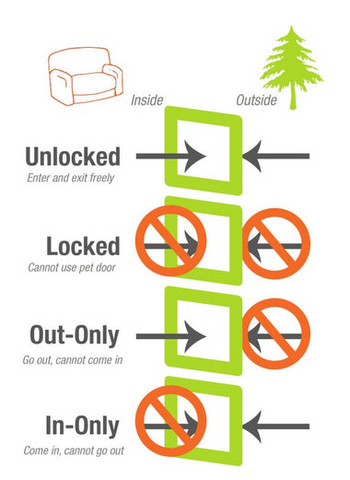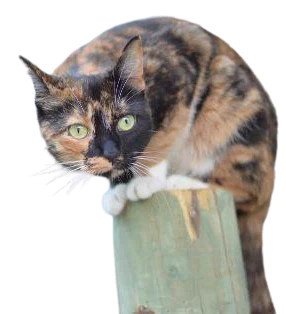Giving your feline friend the independence they crave while maintaining your home’s security is easier than you think with Pet Doors For Cats. These ingenious devices offer a seamless blend of freedom for your cat and convenience for you. Whether you’re looking for a simple cat flap or a high-tech electronic pet door, understanding the options available is the first step to making the right choice for your home and furry companion.
Cat doors, also often referred to as cat flaps or kitty doors, come in a diverse range of designs to suit various needs and home setups. From classic door-mounted models to window inserts and advanced electronic versions, the ideal solution is out there waiting to be discovered. Factors like size, functionality, and style play crucial roles in selecting the best pet door for your specific requirements, be it for a door, wall, or window installation.
Need a small cat door for a petite feline, an insulated exterior door to combat drafts, or an interior cat door to discreetly place a litter box? The market offers a plethora of options. Modern cat doors boast features like microchip recognition, 4-way locking systems, and collar keys, providing controlled access and enhanced security. Many are designed with your cat’s comfort in mind, featuring durable acrylic flaps that are easier for cats to navigate than traditional soft vinyl flaps.
Installation is generally straightforward, with models designed for doors, walls, and windows. This adaptability allows you to strategically place the cat door in the most convenient and suitable location. Furthermore, electronic models offer peace of mind with features that ensure only your cat can enter, often syncing with their microchip or a special collar key.
Durability is a key consideration, and most cat doors are built to last, featuring robust, rigid flaps that can withstand daily use. The ultimate aim is to provide a cat door solution that not only meets your pet’s needs but also upholds your home’s security and your pet’s safety.
Explore the wide world of cat doors and unlock the perfect balance of feline freedom and home security. These easy-to-install solutions are a game-changer for pet owners seeking to enhance their cat’s independence without compromising on home comfort and safety.
Frequently Asked Questions About Cat Doors
Is it Safe to Let My Cat Roam Freely?
A common concern among cat owners considering cat doors is outdoor safety. While cat doors grant access to the outside, they unfortunately can’t confine your cat to your yard. If outdoor safety is a primary concern, a cat door alone won’t solve the issue of keeping your cat within your property.
However, cat doors can be incredibly useful for creating safe zones within your home, such as allowing access to a garage or a specific room. For interior installations, especially in walls, opt for cat doors that include tunnel sections. These sections effectively frame out the wall opening, simplifying the installation process. You can find these convenient tunnel sections at Cat Door Tunnel Sections. Choosing a cat door with tunnel sections makes wall installations significantly easier and cleaner.
How Do I Install a Cat Door?
Kitty doors are available in a variety of sizes, functionalities, and styles, ensuring you can find the perfect fit for your home. Whether you need a cat door for a window, wall, or door, the installation process is generally similar. Here’s a step-by-step guide:
-
Measure and Mark: First, measure your cat’s height to determine the appropriate height for the door opening. Mark this height on the door where you plan to install the cat door. Use this mark to draw a square or rectangular outline for the door opening.
-
Drill Pilot Holes: Drill holes at each corner of the marked area. These holes will serve as starting points for your saw blade.
-
Cut the Opening: Using a jigsaw, carefully cut along the marked lines to create the opening. Once the cut is complete, smooth out any rough edges for a clean finish.
-
Position and Mark Screw Holes: Place the cat door frame into the cutout. Use a pencil to mark the locations for the screw holes through the pre-drilled holes in the cat door frame.
-
Drill Screw Holes: Using a drill bit slightly smaller than the screws provided with your cat door, drill pilot holes at the marked screw locations.
-
Secure the Cat Door: Position the cat door in the opening and secure it by inserting and tightening the screws into the pilot holes. Finally, use blanking plugs or screw covers to conceal the screw heads for a neat appearance.
 Installation steps for a cat door
Installation steps for a cat door
Will My Cat Actually Use a Cat Door?
The million-dollar question! While physically cats are certainly capable of using cat doors, their willingness is another matter entirely. Ultimately, whether your cat uses the door is up to their individual personality and comfort level.
However, there are ways to encourage your feline friend. Positive reinforcement is key. Use treats and praise to associate the cat door with positive experiences. For magnetic closure doors, you can initially reduce the magnet strength to make it easier for them to push through. Some electronic doors even have a training mode to help cats adjust gradually. Interestingly, larger cats sometimes hesitate with smaller cat doors, mistakenly thinking they won’t fit, even when they can. Patience and encouragement are your best tools in helping your cat embrace their new doorway.
How Can a Cat Door Prevent Unwanted Animals?
Security is a valid concern when installing a cat door, whether it’s on your front or back door. The risk of unwanted critters entering your home is real. One simple deterrent is to choose the smallest cat door size that your cat can comfortably use.
For enhanced security, electronic cat doors are an excellent solution. Unlike manual flaps, these doors use electronic mechanisms to control access. Many electronic models feature selective entry systems that recognize your cat’s microchip or a special collar key, granting entry only to your pet. Some advanced models, like the Cat Mate 359, even include built-in timers for added control and security. These features significantly improve front door security and give you peace of mind.
How Often Will I Need to Replace Cat Door Parts?
Most cat doors are designed for durability. Cat doors typically come with rigid flaps made from materials like acrylic, which are highly durable and long-lasting. Flexible vinyl flaps, while sometimes found in cheaper models, are more prone to wear and tear and may require replacement over time, especially after exposure to harsh weather or frequent use. Investing in a cat door with a rigid flap generally means less maintenance and fewer replacements in the long run.
What’s the Difference Between a Cat Door and a Dog Door?
The variety of cat doors available often surprises pet owners who are used to the traditional dog door market. Historically, pet doors were primarily marketed for dogs, categorized by sizes like small, medium, large, and extra-large. The influence of UK designs brought about the rise of “cat doors,” often characterized by a more square shape, rigid flaps, plastic frames, and sometimes even integrated brushes to help groom cats as they pass through.
While these distinctions still exist, many pet owners now use cat and dog doors interchangeably. The key is to prioritize features that meet your specific needs and your pet’s comfort. If a particular pet door, regardless of whether it’s marketed for cats or dogs, offers the features you desire, it’s likely a suitable choice. Ultimately, the best pet door is the one that makes your pet happy and your life easier.
What is a 4-Way Lock on a Cat Door?
A 4-way lock offers greater control over your cat’s access compared to simpler 2-way locking mechanisms. Standard 2-way locks usually just have “Locked” and “Unlocked” settings. A 4-way lock expands these options to include:
- Unlocked (Two-Way Entry): Allows your cat to enter and exit freely.
- Locked (No Entry): Prevents entry and exit in both directions.
- Out-Only: Allows your cat to exit but not re-enter. This can be useful for keeping your cat out during the day.
- In-Only: Allows your cat to enter but not exit. This setting is ideal for ensuring your cat is safely indoors at night.
The PetSafe 4-Way Locking Big Cat Door for Doors is a popular manual option with this feature.
Electronic pet doors may also incorporate a 4-way lock, which will override the electronic settings when engaged. For example, even if your cat has a collar key for electronic entry, setting the door to “out-only” will prevent any animal, including your cat, from re-entering. Cat doors with 4-way locks always feature rigid flaps, which are necessary for the locking mechanism to function correctly.
 Diagram of a 4-way locking mechanism on a cat door
Diagram of a 4-way locking mechanism on a cat door
Can I Get Replacement Parts for My Cat Mate Door’s Sliders?
Unfortunately, for small, specific parts like the red locking sliders or dials found on Cat Mate doors, replacements are typically only available directly from the manufacturer. For these types of components, contacting Cat Mate customer service is usually the best course of action.
What is the Best Type of Cat Door Overall?
“Best” is subjective and depends on your individual needs and your cat’s temperament. However, here are some top recommendations based on specific features:
- Microchip Cat Doors: For selective entry and preventing unwanted animals, SureFlap is a highly recommended brand.
- Energy-Efficient Cat Doors: If energy efficiency and insulation are priorities, Endura Flap cat doors are an excellent choice.
- Soft Vinyl Flap Cat Doors: For doors with flexible flaps, Hale Pet Door is a reputable brand known for quality.
- Manual Hard Acrylic Flap Cat Doors: For reliable manual operation with rigid flaps, Cat Mate doors are a solid and popular option.
For personalized advice, contacting a customer service expert who can discuss your specific situation and needs is always a great idea.
Do You Offer the Cat Mate Medium Cat Door 221?
Yes, the Cat Mate Medium Cat Door 221 is indeed available. This popular model features a 4-way lock and is well-suited for both cats and small dogs. Its versatility, durability, and ease of use make it a favorite among pet owners. Always remember to accurately measure your pet to ensure the medium size is appropriate. If you’re unsure about sizing, customer service teams are readily available to assist you. You can purchase the Cat Mate 221 directly through the website or by contacting sales.
How Do I Train My Cat to Use a Pet Door?
Training your cat to use a pet door may require patience, but most cats can learn with the right approach. Here are some helpful training tips:
-
Prop the Flap Open: Initially, prop the cat door flap open so it’s not obstructing the opening. Use treats or toys to lure your cat through the open doorway. Once they move through comfortably, gradually lower the flap, little by little, over several training sessions. This helps them get used to passing through the opening.
-
Positive Reinforcement: Never force your cat through the door, as this can create fear and aversion. Instead, make training a positive experience with lots of praise, treats, and rewards each time they interact with the door positively.
-
Patience and Persistence: It may take time for your cat to adjust to the idea of using the door. Don’t be discouraged if they don’t immediately take to it. Consistency and patience are key. Keep practicing regularly and maintain a positive and encouraging attitude.
If your cat seems particularly hesitant about flaps, consider a hole-style entry like the PetSafe Cat Corridor Interior Pet Door, which offers an alternative entry style without a traditional flap.
 Cat being trained to use a pet door with treats
Cat being trained to use a pet door with treats
What if I Have Multiple Cats, But Only Want Some to Use the Door?
For households with multiple cats where selective access is needed, an electronic pet door is the ideal solution. These doors utilize microchip or RFID technology to identify individual pets. You can program the door to recognize specific microchips or collar tags, allowing only designated cats to use the door. This provides a simple and effective way to control which cats have outdoor access. If some of your cats aren’t microchipped, compatible RFID collar tags can usually be purchased separately.
Can I Install a Cat Door on a Screen Door?
Yes, installing a cat door on a screen door is possible, but you’ll need a specific type designed for screens. Screen pet doors are engineered to fit into the corner of a screen door and are typically secured by the screen door frame itself. These doors are generally lighter and more flexible than standard cat doors, making them suitable for the delicate nature of screen doors. However, they may not be as robust or feature-rich as traditional cat doors. Consider your specific needs and priorities when choosing a screen door cat door, as they may offer less insulation and security compared to solid door models.
What’s the Best Cat Door for Cold Climates?
If you live in a cold region, prioritize cat doors designed for cold weather. The best options offer insulation and weather seals to minimize drafts and heat loss. The Endura Flap Pet Door stands out as an excellent choice, featuring a dual-flap system, magnetic seals, and an energy-efficient design built to withstand harsh conditions and maintain your home’s temperature. The Cat Mate 221 is another good option, offering insulation and brush weather stripping to prevent drafts. When shopping for a cold-weather cat door, always look for keywords like “insulated,” “weatherproof,” or “energy-efficient” in the product descriptions to ensure optimal protection against the cold.

